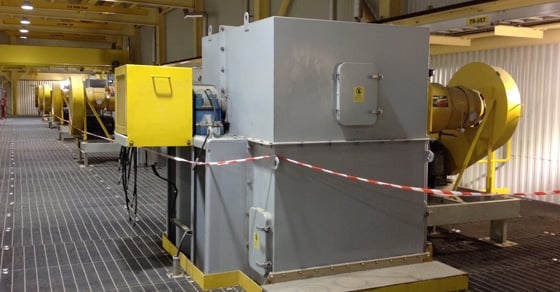Bucket elevators provide an ideal means of vertically transporting material throughout a facility, minimizing the equipment footprint and providing reliable, continuous high-capacity bulk handling.
Many questions arise when purchasing a bucket elevator, including what capacities and customizations are available, but often forgotten are the questions the manufacturer will ask of the buyer.
Whether replacing an existing bucket elevator, or building a new plant altogether, there are a few crucial decisions the purchaser should be prepared to make during the buying process. Here are some of the key design decisions that will require consideration when engaging a bucket elevator supplier.
1. Centrifugal or Continuous Bucket Elevator?
Bucket elevators are primarily manufactured in two different discharge configurations: centrifugal and continuous. One of the first questions a bucket elevator manufacturer will ask is which elevator style the project calls for.
While both designs offer continuous vertical conveying, each style operates differently, with the choice between the two depending largely on the specific requirements of the material.
Continuous Bucket Elevators
Continuous-style bucket elevators operate at slower speeds and lower capacities, offering gentle handling for materials that are fragile or susceptible to aeration; they are the preferred choice for applications such as potash and other fertilizers where degradation or attrition is a concern.
Continuous bucket elevators are also the best choice when handling materials that are either abrasive or inconsistent in particle size; the scooping and throwing action of the centrifugal-style elevator does not lend well to these types of materials.
How Continuous Bucket Elevators Work
Material is fed from a chute into buckets as they pass through the boot section. Buckets are designed and arranged in a way that allows the back of each bucket to serve as a discharge surface onto which the previous bucket’s material passes, making its way to the discharge chute via gravity.
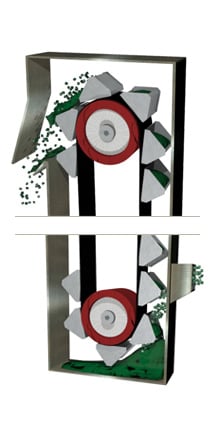
The image above illustrates the operation of a continuous-style bucket elevator. Note how the material is fed via a chute and discharged on the back of the previous bucket.
Centrifugal Bucket Elevators
Centrifugal-style elevators are better suited to faster, smoother handling applications where degradation or aeration of material are not a concern. This type of handling is typical of free-flowing or powdered materials and is often used for sand and ore.
How Centrifugal Bucket Elevators Work
The centrifugal elevator style self loads by scooping material from a hopper as it passes through the boot section. On passing over the head pulley, the buckets discharge material by “throwing” it into the discharge chute via centrifugal force. This elevator type operates at higher speeds and accommodates greater capacities, and as such, is the preferred choice at shipping terminals and other high-volume settings.
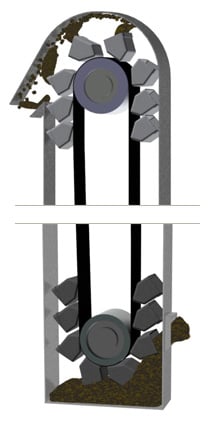
The image above illustrates the operation of a centrifugal-style bucket elevator. Note how loading is primarily a result of the buckets scooping material and discharge occurs as a result of “throwing” via centrifugal force.
As can be seen, each elevator type offers distinct capabilities that make it better suited to different applications. A summary of these differences is provided in the table below.
| Continuous | Centrifugal | |
| Operating Speed | Slow | Fast |
| Capacity | Lower | Higher |
| Best for | -Inconsistently sized material or material with large lumps -Material that is light and fluffy or prone to aeration -Material that cannot suffer degradation -Highly abrasive material | -Free-flowing materials where degradation is not a concern -Materials that can withstand the scooping and throwing action characteristic of this style |
| Loading Mechanism | Fed through a chute | Scoops material from hopper (some direct loading can also be used) |
| Discharge Mechanism | Gravity; material flows off the back of previous bucket into discharge chute | Material is “flung” from the buckets into the discharge chute via centrifugal force |
In some cases, the best elevator configuration is not clear. In cases such as these, it is critical to work with an expert to achieve the best handling solution.
Similarly, depending on the application, one may find that both types of elevators are needed at the facility because of changing material characteristics at different points in the process.
2. Belt or Chain?
The bucket elevator manufacturer will also want to know whether a belt- or chain-type elevator is preferred. Both belt and chain bucket elevators offer a reliable handling solution, with the decision between the two types coming down to practicality and cost.
Belt Bucket Elevators
Belt elevators offer a cost-effective solution for applications such as sand handling (a centrifugal belt-style elevator with nylon buckets offers a highly effective and economic option in such settings). They are also the preferred choice when noise is a concern, as they are much quieter than their chain counterparts.
This elevator style does, however, have some limitations. While less costly, they are not as durable as chains, making them less of a fit for especially demanding applications, such as those found at mine sites. They are also not recommended when the material to be handled is hot, or presents a risk of combustion. Further, since large particles could become wedged between where the bucket is mounted onto the belt, causing damage, the belt-style elevator is best suited for smaller particle sizes ( roughly ¼” and smaller) that avoid this risk.
While smaller belt elevators can handle capacities comparable to that of a chain elevator, this is only true up to a point; in addition to a lower tensile strength, their capacity is limited by practicality; beyond a certain capacity, the size of the casing and components required would be impractical.
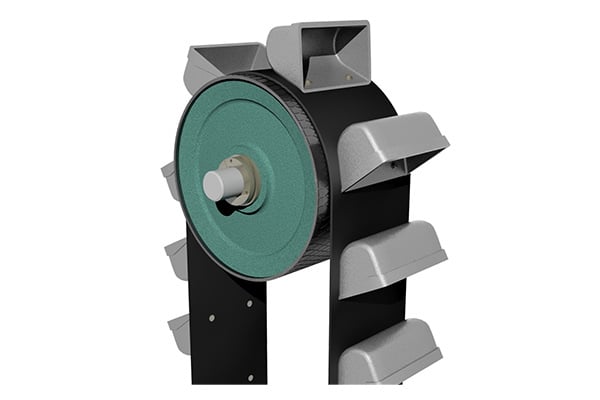
A centrifugal belt-mounted bucket elevator
Chain Bucket Elevators
While chain elevators are more costly, they can withstand a higher level of duty. They are the typical selection for mine sites and other high-capacity operations that demand rugged handling.
Chain elevators are also the best option for handling higher-temperature (greater than 400°F) or potentially combustible materials, as well as materials of a larger particle size that could otherwise become lodged between a bucket and belt.
Elevators employing larger buckets typically utilize a dual-chain design.
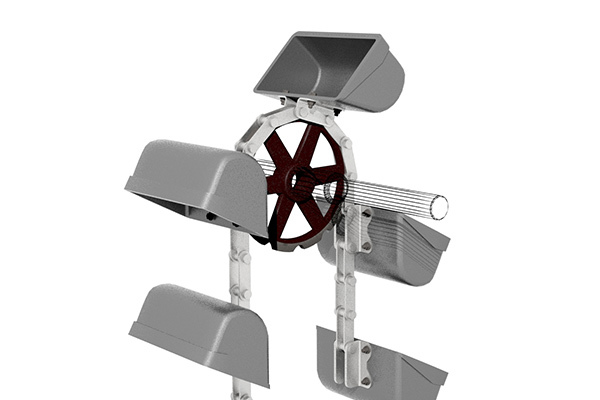
A centrifugal chain-mounted bucket elevator
3. What’s the Best Bucket Style for my Application?
A well-chosen bucket style often means the difference between seamless production and constant downtime for bucket repair or replacement. Elevator buckets are available in a wide range of styles and materials depending on whether the chosen elevator is of the continuous or centrifugal design.
A variety of bucket styles are recognized by the Conveyor Equipment Manufacturer’s Association (CEMA). Some of the most commonly used bucket styles are outlined here.
Buckets for Continuous Elevators
Buckets for continuous elevators must be designed to help facilitate a smooth discharge from the bucket onto the back of the previous bucket. Typical styles for this type of elevator include:
Medium Front (MF) Buckets
Medium front or MF buckets are the most common bucket style chosen for continuous elevators. This bucket style is ideal for materials that are light and fluffy, or require gentle handling.
High Front (HF) Buckets
High front or HF buckets are a variation of the MF bucket, designed with a higher front lip to accommodate additional capacity.
Super Capacity (SC) Buckets
Super capacity or SC buckets offer greater ruggedness and capacity for especially tough jobs. However, because of their size, they can only be used in conjunction with double-chain bucket elevators.
Buckets for Centrifugal Elevators
Since centrifugal elevators will require the buckets to scoop up material, buckets in this category are equipped with a reinforced lip on the leading edge in order to discourage any distortion during digging.
Bucket styles typically chosen for this elevator type include:
AA Buckets
AA buckets are the most commonly employed bucket style for centrifugal elevators. They are ideal in applications requiring durable buckets, such as those found in mining and aggregate operations.
AC Buckets
AC Buckets are chosen for especially heavy-duty applications, or when the material being conveyed is hot or highly abrasive. This bucket style also accommodates a much higher capacity than the AA bucket style.
CC Buckets
Close-centered, or CC buckets are an increasingly popular bucket style for centrifugal elevators. The bucket’s unique shape, along with a design that allows buckets to be spaced closer together, offers additional capacity over what AC buckets can handle.
Bucket Customization
Whether centrifugal or continuous, buckets can be customized in a variety of ways to improve their performance in the given handling task. Customizations include:
- Addition of vent/drain holes
- Material of construction (Fabricated carbon steel, stainless steel, aluminum, plastic, ductile iron, nylon, etc.)
- Punching pattern
- Abrasion-resistant lips on metal buckets
- Custom shapes and sizes for metal buckets
4. What Sort of Access to the Elevator Do I Need?
The need for bucket elevator accessibility is also something that the buyer must consider.
Inspection doors are important for troubleshooting or routinely examining elevator performance and the overall condition of the equipment. Further, some operations may require access doors that allow for easy access to the unit’s internals for changing or cleaning buckets, shoveling or washing out the boot section, or other routine maintenance procedures.
Bucket elevators typically come with access doors at the boot section and inspection doors at the head section, but additional access or inspection doors may be helpful at the intermediate sections as well, depending on the applications. Depending on where the bucket elevator is located in the plant, and the surrounding infrastructure, ladders and safety cages, as well as platforms may also be necessary.
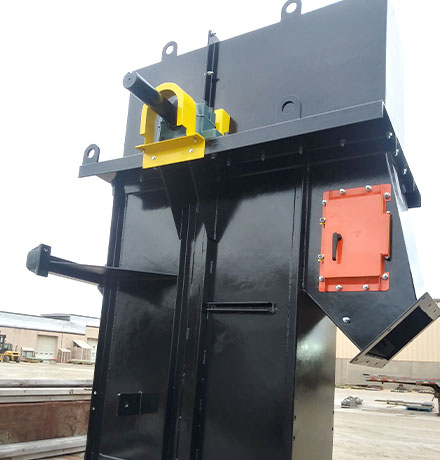
Inspection door (orange) on a bucket elevator head section
Conclusion
The purchase of a new bucket elevator requires several design decisions on the part of the purchaser. For those new to bucket elevators, FEECO can walk you through the process and provide guidance on critical decisions based on your handling requirements and goals.
FEECO has been providing reliable bucket elevators to a range of industries since 1951. Our diverse material experience, combined with our flexible design process and high quality standards, ensures you get the best handling system for the job. For more information on our bucket elevators, contact us today!

